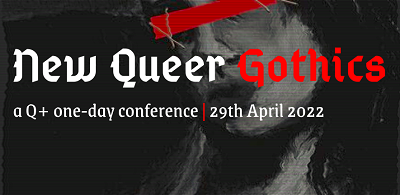New Queer Gothics
A one-day conference hosted by Q+ at the University of Cambridge
29th April
Ghosts, zombies, vampires, faeries, demons – all non-human monsters threatening to corrupt our souls based on dangerous proximity to our minds, our skin, our beds. The monster, as Jeffrey Jerome Cohen writes, de-monstrates the anxieties of the cultural body from whence it is born. The politics of the body are entwined with the gothic: from Foucault’s abnormal defined as half-animal, doubled, or hermaphroditic, to Shildrick’s view of the cissexual female body as gothic monstrosity by right of its transgressive leakiness, threatening the defined boundaries of the whole, healthy form. As a Frankensteinean rearrangement of parts that disrupts the whole, the monster scrambles our notions of corporeal possibility; as such, she has proven an enduring favourite for conceptualising trans embodiments (Stryker, Malatino, Preciado).
Not only the politics of specific bodies, but also entire body politics have historically been prone to gothicisation. Vampirism for Marx could metaphorise capital’s way of subsisting on the lifeblood of human labour. For Achebe, the portrait of Dorian Gray distils the vampiric relationship between European states and their colonies. In the Latin American context, the colonial stereotype of cannibalism has been mobilised to describe the tropical gothic’s “mongrel texts” that cannibalize European gothic literary conventions to create fictions that renarrativise the horrors and terrors of colonialism (de Andrade, Edwards and Vasconcelos). New Queer Gothics refers to and extends these embodied and performative deviances from proper personhood, citizenship, or indeed humanness.
The plural “gothics” rejects “the gothic” as a homogenous genre centred on the canonical texts and periods of the Euro-American imaginary, recognising the varying iterations of the gothic across multiple periods and international contexts. This conference places gothic representations of the non-human in conversation with theories of Otherness, the postcolonial double, mis-/representations of disabled or neurodivergent subjects, and anxieties surrounding gender, class, and sexual deviance. Framing non-humanness as iterated on multiple fronts of queered deviation from what Sylvia Wynter calls the “overrepresented” genres of the human, it will explore the necropolitical relationship between humanness and the gothic. This exploration dislodges the normative (white, cis, straight, male) human from ontological eminence, thus furthering our appreciation of the ways in which the gothic has “always been queer” (Hughes and Smith). The queer has of course, from Sedgwick’s foundational interrogation of the unspeakable to Paulina Palmer’s more recent work on the “Queer Uncanny”, also always been gothic. New Queer Gothics speaks back to queer gothic's structuring assumptions, addressing contemporary concerns like:
-
the “haunting” of the university, with particular reference to “decolonising” initiatives
-
queer reproduction, reproductive justice, and reproductive horror
-
“TransGothic” (Zigarovich)
-
“Globalgothic” (Botting and Edwards)
-
“Ecogothic” (Cunningham and Sharper)
-
gothic horror and contemporary design, e.g. “the uncanny valley” and robotics
-
Marxist spectrality/hauntology
|
New Queer Gothics is a one-day conference for scholars working on gothic themes in queer studies, trans studies, gender and sexuality studies, and postcolonial/race and ethnicity studies, prioritising contributions from PhD and early career researchers. Order of Play |
||
|---|---|---|
11.00
|
New Queer Goths Assemble |
|
11.30
|
Defining "New Queer Gothics" |
|
12.00 - 13.00
|
Paige Allen - Haunting Houses: The Queer Possibilities of Posthuman Spaces in Shirley Jackson’s The Haunting of Hill House and Daisy Johnson’s A Bruise the Size and Shape of a Door HandleCarolin Jesussek - Rethinking the Non-Human in Carmen Maria Machado’s Autobiographical In the Dream House (2019) |
|
13.00 - 14.00
|
At which point, lunch |
|
14.00 - 15.30
|
Fey Ameya Kapur - Necrotising Bodies: Vampires, Bloodlust and the Necropolitics of Monstrosity in Transgender Horror StoriesBrontë Schiltz - “A rotter’s a rotter, drugs or no drugs”: screening monstrous queer pathologiesCat Stiles - Queer Creatures: The Genderqueer Embodiment of Monstrosity in Early Modern Literature |
|
16.00 - 17.00
|
Lauren Cassidy - Post-mortems, Postmodernism and Matrixial Myth: The Sovereignty Goddess in Emma Donoghue’s Hood (1995)Jenny Moran - Colonial Transfusion: On the lesbian origins of the contemporary vampireNaoise Murphy - The queer ghosts of Irish lesbian writing |
|
17.00 - 18.00
|
Evelyn Whorrall-Campbell - Leaving the woman behind: the horror of (trans)masculinity from Dandy Dust, the wannabe-patriarchDesmond Huthwaite - What’s Goth(ic) about trans studies now? |
|
References
Achebe, C. (1978). An Image of Africa. Research in African Literatures, 9(1), pp. 1-15.
Andrade, O. de. (1928). Manifesto antropófago. In O. de Andrade, Literatura
Comentada. (J. Schwartz, Ed.). Abril, 1980, pp.81-83.
Botting, F., & Edwards, J. D. (2015). Theorising globalgothic. In Globalgothic (p. 11). Manchester University Press.
Cohen, J. J. (1996). Monster Culture (Seven Theses). In J. J. Cohen (Ed.), Monster Theory (pp.3-25). University of Minnesota Press.
Foucault, M. (1997). Abnormal. (G. Burchell, Trans.). Verso.
Hughes, W. & Smith, A. (Eds.). (2009). Queering the Gothic. Manchester University Press.
Hughes, W. & Smith, A. (Eds.). (2013). Ecogothic. Manchester University Press.
Malatino, H. (2019). Queer Embodiment. University of Nebraska Press.
Palmer, P. (2012). The Queer Uncanny: New Perspectives on the Gothic. University of Wales Press.
Preciado, P. B. (2021). Can the Monster Speak?: A Report to an Academy of Psychoanalysts (F. Wynne, Trans.). Fitzcarraldo Editions.
Sedgwick, E. K. (2008). Epistemology of the Closet. University of California Press.
Shildrick, M. (1996). Posthumans and the Monstrous Body. Body and Society, 2(1), pp.1-15.
Stryker, S. (1994). My Words to Victor Frankenstein Above the Village of Chamounix: Performing Transgender Rage. GLQ, 1(3), pp.237-54.
Wynter, S. (2003). Unsettling the Coloniality of Being/Power/Truth/Freedom: Towards the human, after man, its overrepresentation—an argument. CR: The New Centennial Review, 3(3), pp.257-337.
Zigarovich, J. (2017). TransGothic in Literature and Culture. Taylor and Francis.


